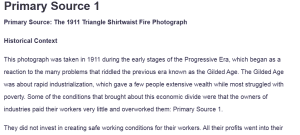Primary Source 1
Primary Source: The 1911 Triangle Shirtwaist Fire Photograph
Historical Context
This photograph was taken in 1911 during the early stages of the Progressive Era, which began as a reaction to the many problems that riddled the previous era known as the Gilded Age. The Gilded Age was about rapid industrialization, which gave a few people extensive wealth while most struggled with poverty. Some of the conditions that brought about this economic divide were that the owners of industries paid their workers very little and overworked them: Primary Source 1.
They did not invest in creating safe working conditions for their workers. All their profits went into their pockets. In addition, there was an influx of workers who needed work to earn a living, and a shortage of jobs placed the workers at a disadvantage in protesting their exploitation and abuse at work. Nevertheless, a new wave of activism started in the late nineteenth century by individuals who wanted change to the moral decay and instability in society brought about by exploitative labor practices.
This particular image is, till today, one of the deadliest industrial disasters in the history of America, whereby the Triangle Shirtwaist Factory had locked workers inside the factory to prevent them from taking breaks, and a fire broke out inside the factory. With nowhere to escape and a lack of inadequate fire escapes, the fire resulted in the death of 146 people, primarily women, and 71 were injured. This tragic event fueled the labor movement, leading to the implementation of the Factory Investigating Commission, whose regulatory advances eventually led to the establishment of the Occupational Safety and Health Administration (OSHA) in 1971.
Analysis Content
The photograph shows policemen in the process of placing the bodies of workers who died either from being burned alive or as they were trying to jump off the building to escape the fire into coffins. The workers of the Triangle Shirtwaist Factory, the same workers some were now dead, had in the previous year gone on strike demanding safer working conditions, better wages, and recognition of their union (Locke & Wright, 2019). However, the factory owners, rather than attending to their workers’ needs, responded by calling the city police to break up the strike.
One of the focal points of the labor movement during the Progressive Era was safer working conditions for workers. The labor movement highlighted the nightmare or dangers of poor working conditions and the image of the nightmare becoming a reality. Even after the death of hundreds of workers, the owners of the company got away with the crimes since they were arrested and shortly released (Locke & Wright, 2019).
The labor movement fought against all the abuse and dangers that workers faced, and by lobbying for unionization, the movement wanted workers to have a collective power to fight for their rights since, as this case showed, the big corporations had the power to stop strikes and get away with killing their workers.
Question
The question that this source leaves me with is that even a century later, these same struggles exist; big corporations still have powerful workers, putting them at a disadvantage when fighting for their rights (Ghaffary, 2022). My question “What is the best strategy that workers can use to advocate for policy changes that make unions a basic right for workers and outlaw any efforts a company takes to fight unionization or intimidate workers, for example, hiring other workers when the current ones go on a strike or other intimidation tactics like being fired?”.
References
Ghaffary, S. (2022). Amazon fired Chris Smalls. Now the new union leader is one of its biggest problems. Vox. https://www.vox.com/recode/23145265/amazon-fired-chris-smalls-union-leader-alu-jeff-bezos-bernie-sanders-aoc-labor-movement-biden
Locke, J., & Wright, B. (Eds.). (2019). The American Yawp: A massively collaborative open U.S. history textbook. Stanford University Press. https://www.americanyawp.com/text/wp-content/uploads/yawp _v2_open_pdf.pdf
ORDER A PLAGIARISM-FREE PAPER HERE
We’ll write everything from scratch
Question
A Primary Source is a letter, document, picture, journal, diary, music score, painting, or any object produced at the time or soon after an event took place, for example, an image of President Theodore Roosevelt or a picture of a Civil Rights protest.
For this assignment choose ONE image or a document from chapters 16 to 26 of the American Yawp. For documents check the Primary Source section from the chapter of the American Yawp. To better understand the image or document you choose, make sure you browse through the chapter in which your primary source is found.
You will write a 1-2-page essay addressing the following points:

Primary Source 1
- Historical Context: Provide a brief background of the historical period in which the source was created. What major events or movements were taking place at the time? Include reference to the chapter of the American Yawp where this information is found. If you use AI assistance, list the AI database you use.
- Analysis Content Summary:
Introduce the source you chose by saying how the source speaks to the historical context. Remember to look for the date and author, if this is not available, skip it.
For example, if the source deals with the labor movement connect it to ideas about inequality, low wages, dangerous work conditions, and the power of big corporations. If the source relates to civil rights movements, discuss its connection to social justice and activism.
Provide a summary of the main points, arguments, or ideas presented in the primary source.
- Question:
What question or questions does this Primary Source leave you with? Or Comment on how effective or not was the source you chose in helping to understand major events or main points addressed in the source.

